The Square: From Spectator to Container of Social Affect
Puerta del Sol Square as a Paradigm
September 14, 2015artist contribution,
Miguel Ángel Rego Robles’ essay demonstrates how Madrid’s public space, the Puerta del Sol, has over the past two centuries been transformed from a “passive body as a spectator” to a paradigm and receptacle of social emotion. This image-essay is part of the Open! Co-Op Academy project “did you feel it?”.
Introduction
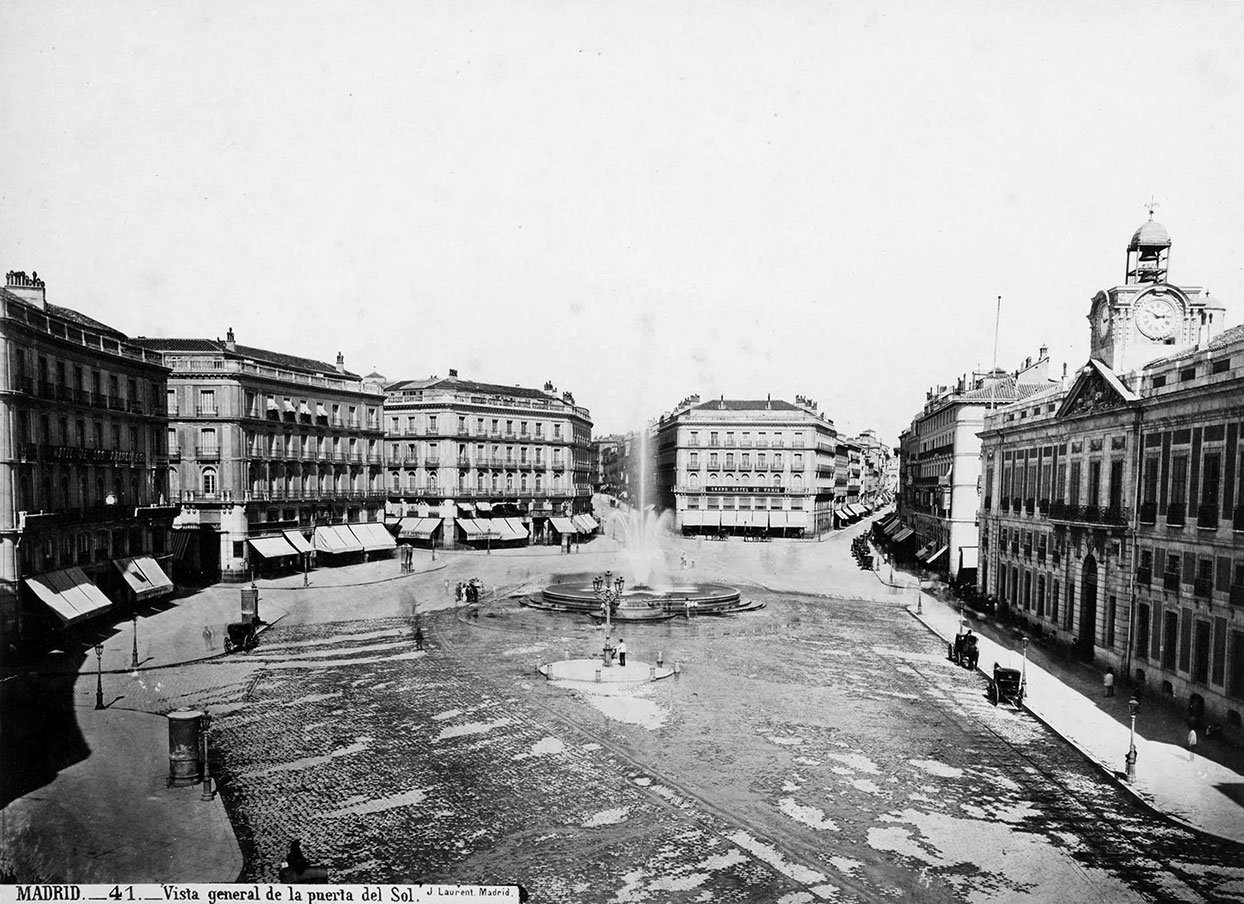
Located in the centre of Madrid and, in broader terms, at the geographic heart of Spain, Puerta del Sol Square is a strategic political enclave as has been demonstrated during the history of this country. This square has been, and continues to be, the direct protagonist of a number of events which have changed the lives of Spanish citizens by contributing to their empowerment and the development of a shared identity.
Although the square is, in itself, no more than an inanimate and passive presence, thanks to actions, meetings, movements or conflicts and the emotions arising from them, what was initially no more than an area of land, has taken on a role as a political and social space and has developed its own character. In other words, the square ceases to be merely an observing location to become an agent with symbolism and meaning, a space of political change, of social and emotional messages. A place where responses have been generated in terms of intensity, which have helped to create a specific social imaginary.
Thus, it is necessary to bear in mind not only how the public space of the Puerta del Sol is used but also the symbolic and imaginary space produced from its representation.
Affectivity is understood as a nonconscious state of the human being. “L’affect (Spinoza’s affectus) is an ability to affect and be affected. It is a prepersonal intensity corresponding to the passage from one experiential state of the body to another and implying an augmentation or diminution in that body’s capacity to act.”1 I will study the factor of confluence of different external agents (social and representative) in relation to different historical moments.
We will bear in mind aesthetic, political and emotional criteria, such as the visual representation of the square. In this analysis based on the importance of the power of the images and their messages will be examined, as well as its use, the handling and appropriation of that representation. Throughout this text, I will describe three events that have helped make the Puerta del Sol one of the currently most powerful symbols of social affectivity for Spanish society: the uprising of the people of Madrid against Napoleon’s troops, the establishment of the Second Republic in Spain and the most recent event, the 15-M movement’s camps in 2011.2
But history has also shown us how affectivity, born from a social impulse, may be used by institutions and private bodies, as is the case of Vodafone, and how it became a political and economic tool. I will talk about this aspect at the end of the text.
1808: The Spanish War of Independence
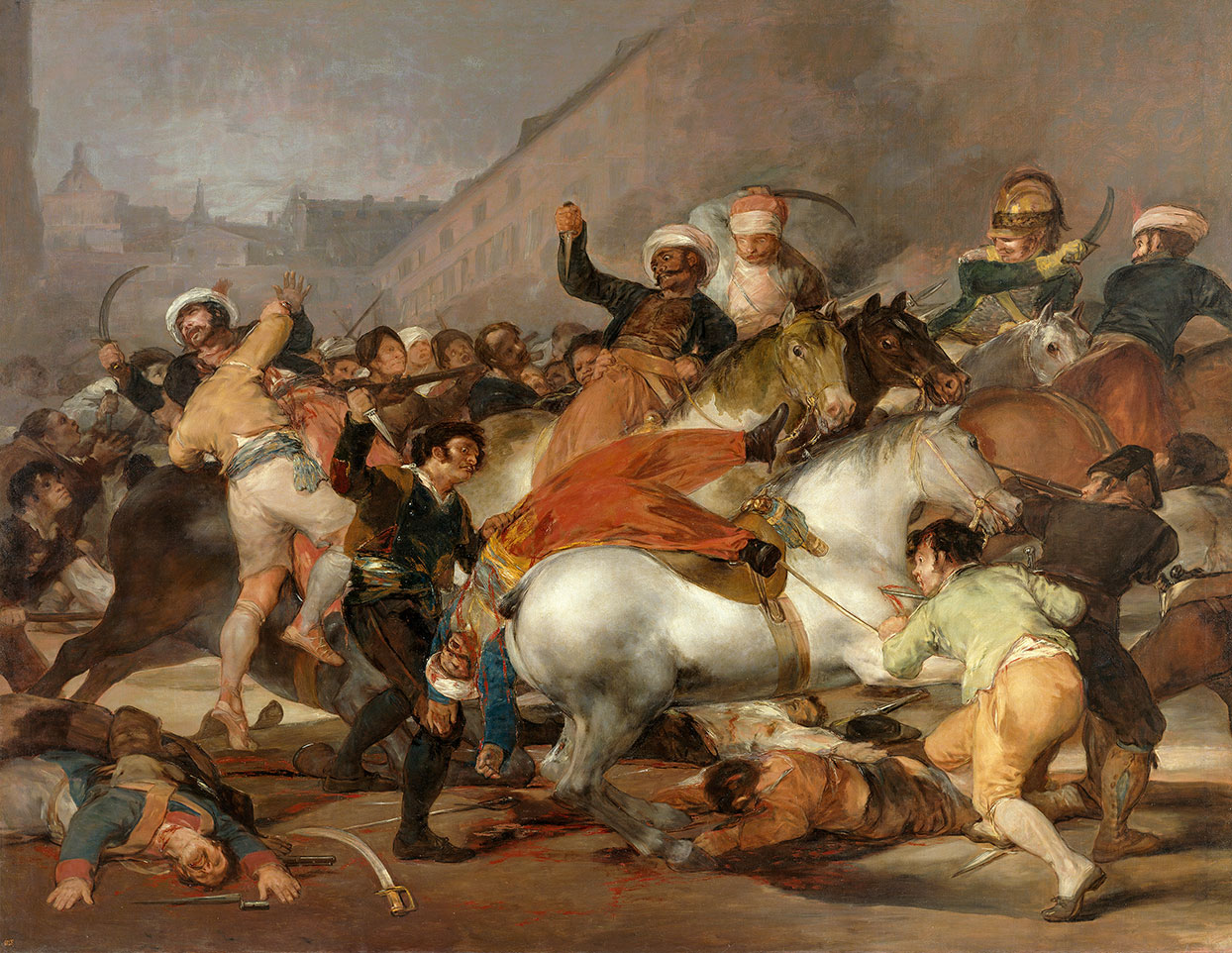
May 1808: On the first of May, the citizens of Madrid began an uprising in the Royal Palace against the French occupation and, more specifically, against the imposed governor, Napo-leon’s brother, Joseph Bonaparte. The next day, the popular uprising moved to the Puerta del Sol, giving rise to the Spanish War of Independence. The bloody struggle was repre-sented in many drawings and paintings by Francisco de Goya, among other artists. In a pe-riod prior to the birth of photography, these representations were created during the actual battles, where the spectator contemplated a vision immersed in the structure of the square, showing him as part of the event.
The unfolding and consequences of the Puerta del Sol uprising were fully represented, creating a set of images based on a “response”. This idea of a “response”, which arises in the spectator is dealt with in The Power of Images by art historian David Freedberg, who does not specifically mention the concept of affect but does mention the “capacity of the spectator to generate impulses”.3
After the Spanish victory, various artists presented their versions of the events of 2 May 1808. This was the case with Francisco de Goya, who told the Government he intended to “perpetuate by means of the brush the most notable and heroic actions or scenes of our glorious insurrection against the tyrant of Europe.”4 Goya was able to express the ideal of reproducing an event that was meant to create a coherent record of the battle, concentrating on graphic dramatisation.
The glorification of the Spanish people by means of the representation of suffering and vio-lence created a body of images that not only documented history, but also unleashed a popu-lar emotion. Instead of concentrating on a lone figure as the protagonist, Goya created an emotional devotion with his images of an anonymous mob as a unique actor immersed in the most brutal violence. The visibility of the bodies struck down only moments earlier, the expressions of pain on their faces, their alertness, the before and after instants of daggers and swords plunging into the flesh of the enemy, and the blood which seems to flood the painting are all part of Goya’s characteristic dramatic details he so consciously employs.
Thus, chronologically, first a sense of the people was created in terms of emotion rising up against the oppressor and fighting in the streets; and then the intention appears of not only portraying what had occurred, but also to transmit in emotional terms the uprising through the exaltation and the violence of the battle opting for an iconography that is different from the traditional. In summary, the events first took place and were then portrayed.
1931: The Second Spanish Republic
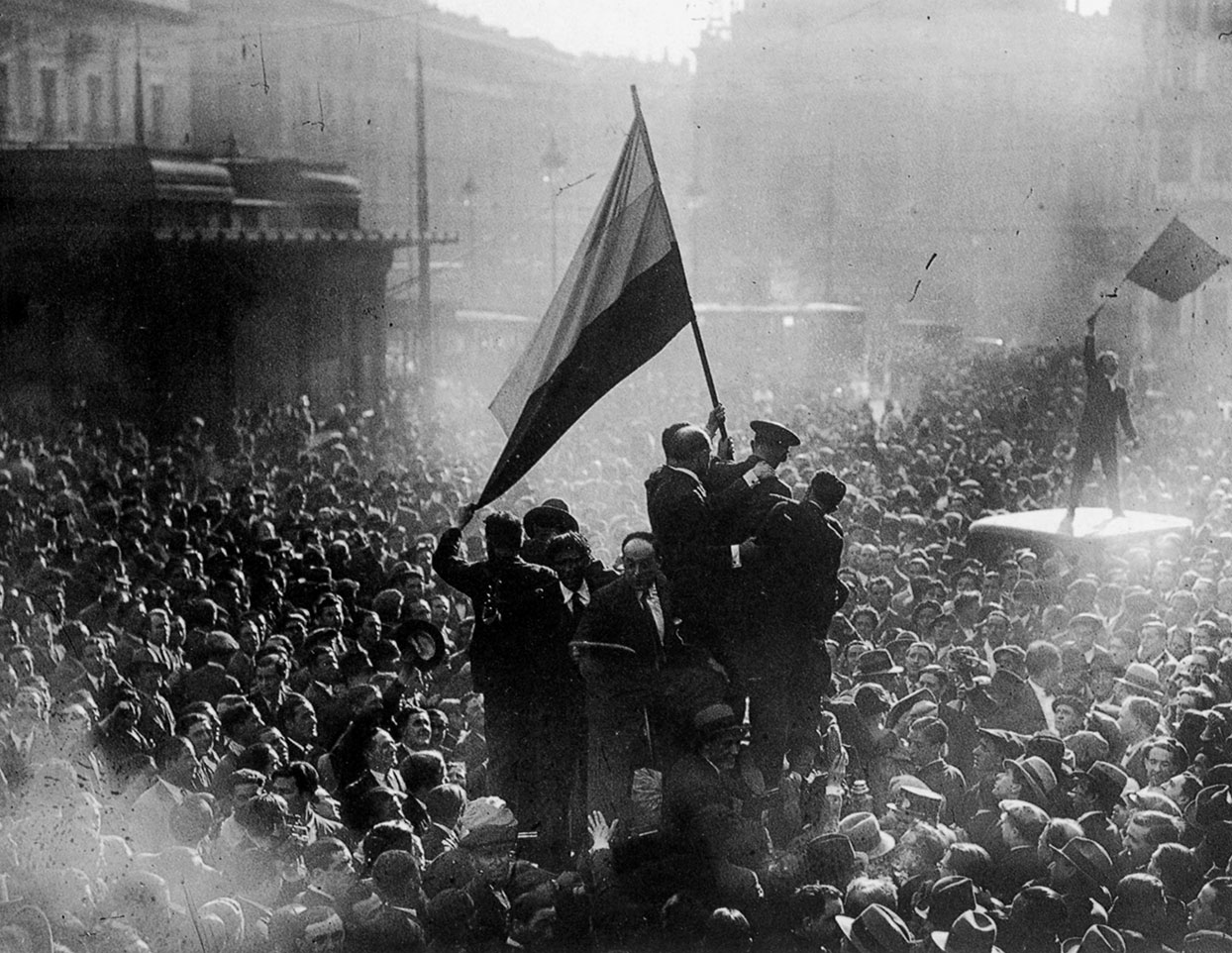
In the April 1931 general elections, the Spanish opted for significant political change: the establishment of the Second Republic.5 Spanish society underwent a notable change that coincided with a period of progress for the autonomous workers movement. The demands for modernisation and socialisation that included agrarian reform, arose mainly in the rural areas and was accompanied by nationalist sentiment.
King Alfonso XIII6 was not able to avoid the numerous social and political conflicts that arose from these events, with the result that the Monarchy was abolished after the elections by the electorate using democratic mechanisms that were in place.
The country entered a period of mass political complexity. The key setting for viewing these political changes was the Puerta del Sol. The photographs taken at the proclamation of the Second Republic presented a new point of view where the gaze of the spectator was raised up to admire and witness this new configuration: the masses. “The photographer has to prove that what is being shown is not life transformed in accordance with the laws of aesthetics but life itself, life documented with the technical perfection of photography”.7
The photographs taken during these events clearly show the celebration of the Republican victory at the Puerta del Sol. They emphasise the inscrutable nature of the image, which is related to its aesthetic power, which allow for a more precise analysis. The photographic framing concentrates on the revolt of the people who shared a common view of social class, as they surround their compatriots who are seen hoisting a shared flag to celebrate a political change of direction. The exaltation of social affectivity at the Puerta del Sol materialises at that instant and is captured by the photograph.
In this context, it is also necessary to mention one of the most important essays on photography, Roland Barthes’s “Camera Lucida: Reflections on photography”. Although the French semiologist realised that it was impossible to speak of photography’s essence, it was possible to analyse the response to the photo. In this regard, Barthes differentiates between what he called the studium and the punctum.
Barthes described the punctum as involvement in the response of the spectator’s body – the photograph as a puncture wound. “Punctum is also: sting, speck, cut, little hole and also a cast of the dice. A photograph’s punctum is that accident which pricks me (but also bruises me, is poignant to me).”8 It corresponds to that semantic opening produced by photography as a result of its “sovereign contingency…, what Lacan calls Tuché, the Opportunity, the Meeting, the Real”9 as manifested in the unknowable of its representation.
Although the author is describing this stage in relation to the response, is this wound not related to what Brian Massumi describes as “the second means of unconscious vibration prior to subjective emotion” in his “The Autonomy of Affect”?10 The Canadian theorist further described it as the unconscious intensity that is generated in the spectator in relation to the affect.
Barthes, without entering into the affective arena, astutely analyses the inexplicable part of the spectator’s response in relation to photography. On the other hand, the spectator’s subjective knowledge as he or she views a photograph would be identified as the “studium (the viewer attraction to photography, depending on the culture, his own knowledge and subjectivity) is ultimately always coded, the punctum is not.”11
As we extrapolate the geographical context, while marking a chronological relationship and without abandoning the treatment of the studium and punctum, Soviet artists such as El Lissitski or Rodchenko (who a decade earlier had used the photo-montage technique) severed the relationship between painting and photography. They developed a new stage within this technique that was called “factographic production”, which is closely related to social realism.
This artistic approach has an effect on aesthetic decisions such as choice of camera angle , which can in turn offer the spectator a new perspective. It created a new set of images that served as a political demand while documenting the transformations of this nascent society12. “Photomontage, in its present stage of development uses finished entire photographs as elements from which it constructs a totality.”13
2011: 15-M
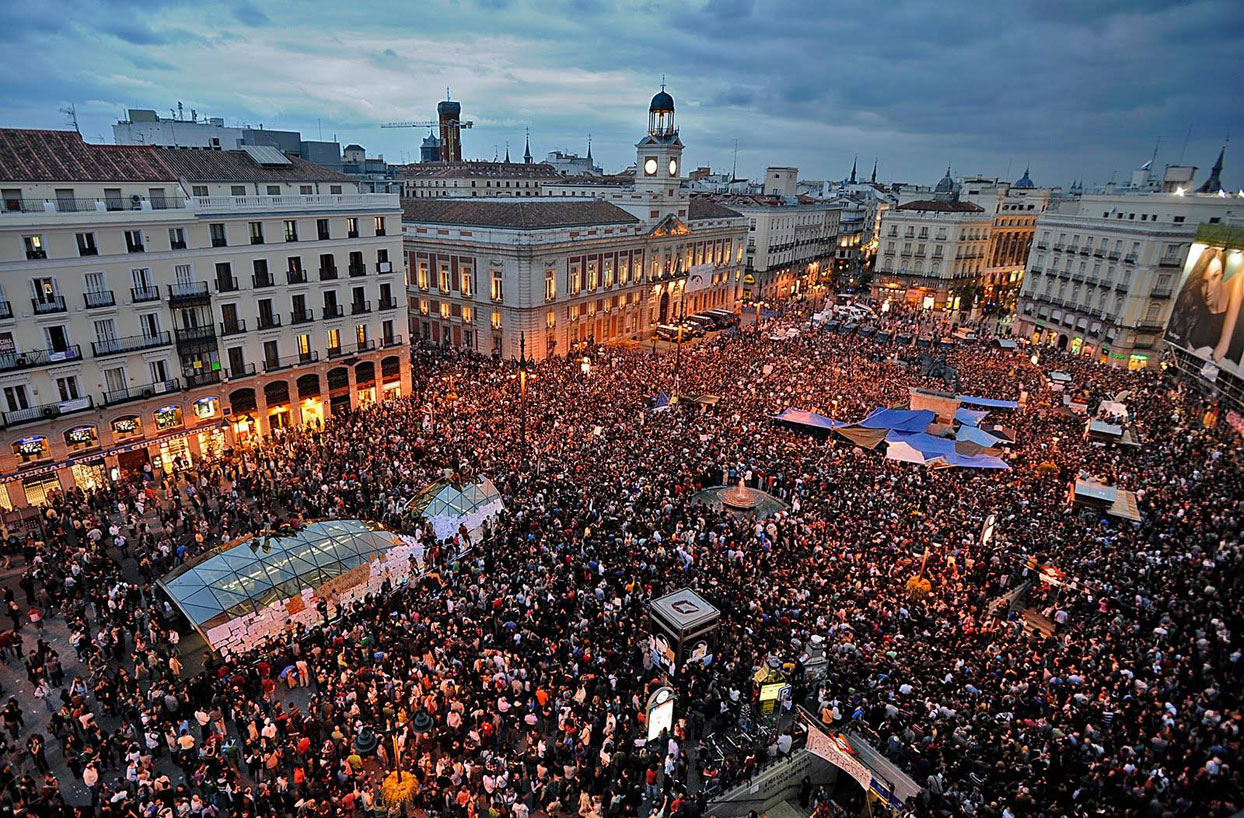
On 15 May 2011, a number of civil society and organisations coordinated a demonstration that involved the entire country. The goal was to express their discontent with the administration’s austerity policies, corruption and the housing crisis. A number of people after the demonstration spontaneously decided to set up a camp in the Puerta del Sol at the end of the demonstration route. But, a few hours later, these demonstrators were evicted from the square by the police, an act which only increased the discontentment already stirring through large segments of Spanish society.
The demonstrators reacted the following day by organising new demonstrations, characterised as very large indignant mobilisations protesting the repression of citizens. The people were no longer merely individual citizens who had chosen to demonstrate. No, from that day on, all of the people who turned up for the demonstrations at the Puerta del Sol or another square in Spain, came together under the newly coined 15-M Movement, a term that clearly revealed their intentions and demands that they shared. Each member of the 15-M movement was dubbed as an “indignado”, an outraged person.
This new sentiment arose from a shared indignation and united a majority of Spaniards, appealing to people of all ages and backgrounds. The protests continued as well as attempts to establish a camp until the “Acampada Sol” was created, which can be described as a social camp that served as a tool to strategically occupy the Puerta del Sol as a symbolic location. It became the centre of the 15-M Movement’s operations and assembly-based self-management decision-making processes.
A number of webcams broadcast the events live, which allowed us to participate not only physically on the square but also, in a less immediate way, through our electronic devices. In this case, the aerial point of view clearly establishes the importance of the square’s architecture as a receptacle of the masses. This aerial perspective also reveals the incorporeal capacity of the individual to operate in terms of identity at several different but “simultaneous levels”, both physically and immaterially, as a result of the broad use of digital technologies.
The visual representation of the masses in this format, content and medium has had a profound political effect how the new subjectivities are configured and used, in affective terms, in the acquisition, appropriation and domination of the new imagination that arose out of the various events we have analysed. Meanwhile, both multinational companies and new political parties have managed to exploit the symbolic and imaginary aspects of 15-M. I will describe this development below.
Dutch media theorist, Eric Kluitenberg, analyses the concept of “hybrid space” in his essay, “Feelings in the Air”, which he describes as “a densified networked sphere in which a multitude of non-conscious affects circulate, impinging on and influencing the bodies of the human political actors.”14 This concept, initially developed by the architects Frans Vogelaar and Elisabeth Sikiaridi, can also be applied in describing the experiences of those who participated in the 15-M camp. Kluitenberg, with regard to “hybrid space”, emphasises that the “media and embodied spaces coexist as heterogeneous elements and flow superimposed upon each other as sedimentary layers within the same spatial confine”.15
On the one hand, it was possible to see, in the physical spaces of protest, the flow of new media such as social networks. These platforms of digital presence, in turn, generated intensities in the acts of sharing, reacting, giving feedback and communicating. As Kluitenberg explained in another essay:16 “self-mediation is primarily characterised by phatic forms of communication, i.e., forms of communication that serve primarily social or emotive purposes, not the transfer of information.”17
On the other hand, the representation of public space in real time established a double presence thanks to streaming platforms. “Flusser elegantly describes a network of densifying inter-human and intersubjective relationships that can be recognised as both an urban as well as a communicative structure.”18 This is how the Puerta del Sol became a containing element of forces of affect at parallel levels of action and identity.
According to Massumi, the autonomy of affect is “autonomous to the degree to which it escapes confinement in the particular body.”19 In short, it transcends the human body. This, according to the theory, means that, during the transformation of affective forces (unconscious) into flows of emotion (conscious), we experience a considerable loss of intensity. One strategy, with all of its respective virtues and defects, involves the development of the political party Podemos.
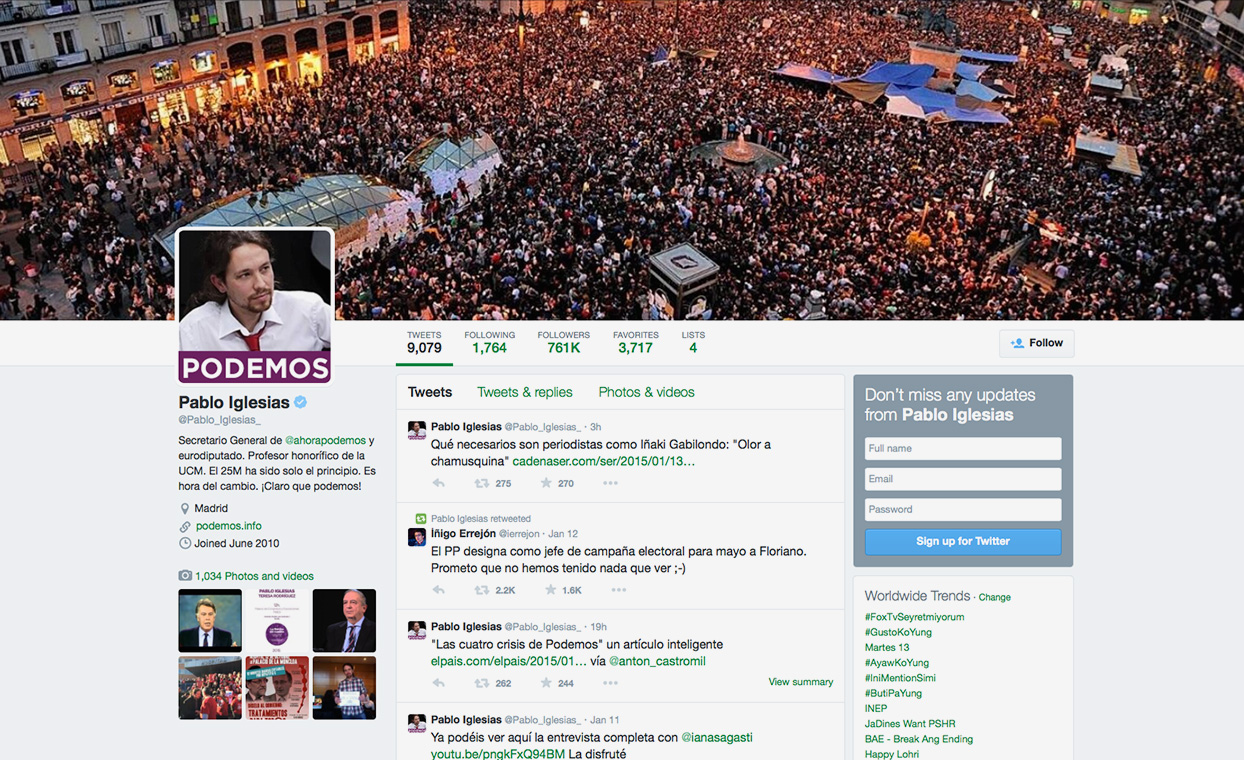
Podemos, in its infancy, attempted to channel the intensity generated by the Puerta del Sol crowds in the 15-M encampment. Its leader, political science professor, Pablo Iglesias, began his relationship with the media as a presenter of a political debate program on a local television station and was eventually invited to a mass media program as a tertuliano or talk show host. Iglesias has always characterised himself as opposed to policies of austerity and by his admiration for the 15-M spirit.
In these public appearances, Iglesias captured the intensity of the movement by making the messages of the so-called “Indignados” his own and the way he positioned himself via the semantic opportunities experienced during the protests. For example, when he referred to the percentage of rich compared to poor – “We are the 99%” – he adapted it to the Spanish context by employing the concept of “caste”, so that, for Iglesias, the 1% would include all the people who engineered the crisis in Spain – the politicians, businessmen and bankers. Furthermore, the very name of the party, Podemos, is based on one of their chants and means “We can” or “Yes we can”. These semantically empty messages are precisely what “made them so highly effective as a resonance object for the displacement of affective intensity across ideological, cultural, and political divides.”20 In no time, 70% of the those who had supported the movement experienced how their collective voices had obtained representation.
The large amount of data and content that the movement generated at the Puerta del Sol was intelligently channelled by Podemos and, to be more precise, via the language used by its unofficial spokesman. Podemos was based on an organisational strategy of representative circles (the circle became the logo of the party). This strategy included a horizontal hierarchy that was organised in district assemblies, companies, institutions and faculties linked via new technologies and social media, which allowed them to channel surplus information and thus create affect among the citizens and direct it toward their organisation.
A strategic promotional campaign that included social media, digital referendums and other means allowed Podemos, during its brief existence, to manage to elect five European Parliament members at the most recent European elections.
Peter Lamborn Wilson, in his critical text “Media Creed for the Fin de Siècle”, notes that “the media constructs the image of a false subjectivity, packaged and sold to the consumer as a simulacrum of his / her own ‘feelings’ and ‘personal opinions’ or subjectivity. And at the same time, the Media constructs (or is constructed by) a false objectivity, a false totality, which imposes itself as the authoritative world-view.”21 This conquest of the media by Iglesias and Podemos was attacked by various actors in an attempt to dismantle the subjectivity they constructed from these messages of semantic openness and broadcast to the people. The lack of specificity in Iglesias’s political proposals for the party was the focus of much of the criticism.
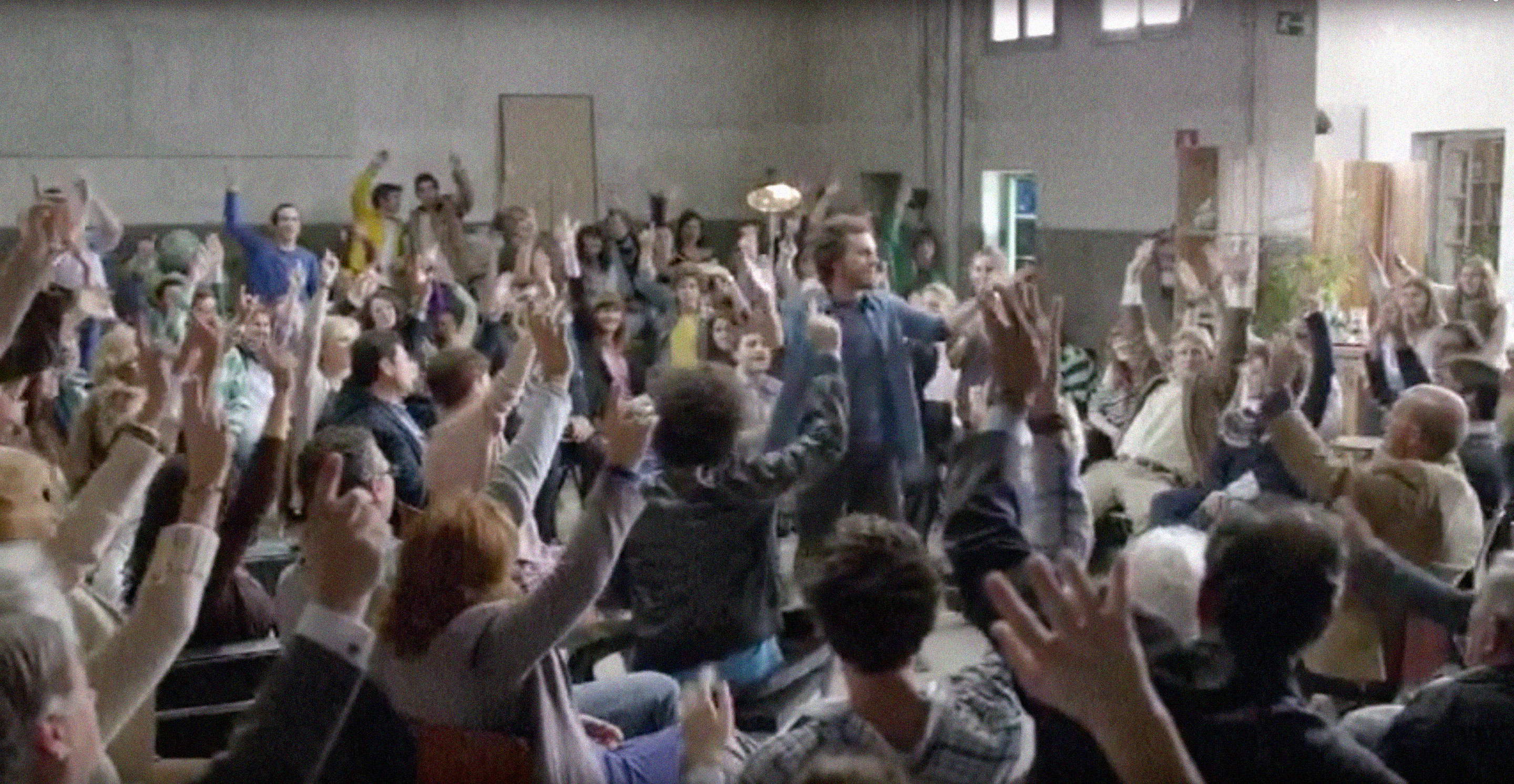
In an example of an appropriation of the protagonists in the square, the multinational Movistar launched a television commercial showing a group of people debating the com-pany’s new mobile telephone rates. Movistar even produced its own the images of the square for the commercial. It caused quite a stir because it had taken advantage of 15-M im-ages, appropriating them to offer their customers the feeling that they were participating in a movement.
But perhaps the most characteristic example of an “act of symbolic warfare”22 and one that has created the most irritation occurred two years later, when the Madrid Regional Government sold the name of the Sol metro station to Vodafone in an attempt to configure the symbolic spectrum of the square in semantic terms. This act not only reveals the cynical appropriation by a multinational, but also the structural and political deficiencies that came to characterise the 15-M Movement.
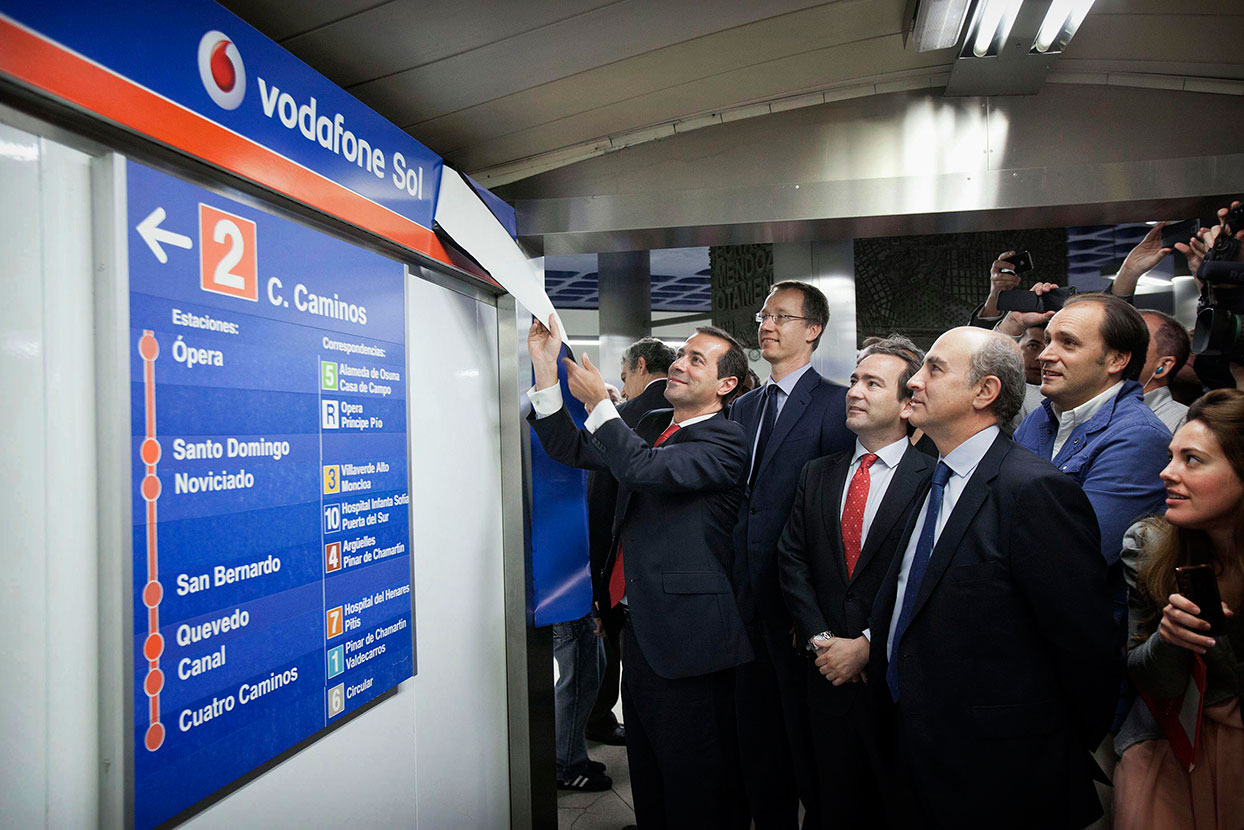
With the sale of this public space, the Sol subway station, for €3 million, Madrid’s politicians had allowed a corporation to appropriate the symbolic opening achieved in a space that has gained a cumulative social meaning through all of the historical events that have taken place there.
Conclusion
We have in the course of this essay analysed a number of events that occurred in the Puerta del Sol at different moments in time. The common denominator for each of these events has been the involvement of the group that helped define its form thanks to a shared identity. The common thread of each of these events has been the medium with which the group rep-resented itself and, which was then emphasised in the role that each of the aforementioned representations played.
The specific purposes of the various movements are associated with the notion of what can be perturbed in the body of the spectator, from the Freedbergian response and the Barthesian punctum to the hybrid spaces of resistance in the 21st century.
The vantage point of the representation, as it occurred, has a connotation and an inherent meaning in relation to the subjectivity of each represented time period.
If we place more emphasis on the most recent events, we notice a complexity in terms of the appropriation and manipulation of the representation, by both companies that take advan-tage of the symbolic and semantic possibilities and by the newest political parties who all emphasise hope in an effort to unite a majority of the people who have similar issues and criticisms.
Puerta del Sol has been transformed from a passive body as a spectator to a paradigm and receptacle of social emotion.
1. Gilles Deleuze and Felix Guattari, A Thousand Plateaus: Capitalism and Schizophrenia, Minneapolis and London: University of Minnesota Press, 1987, p. 16.
2. A citizens movement formed after the demonstrations of May 15, 2011 that advocated a more participatory form of democracy.
3. David Freedberg, The Power of Images: Studies in the History and Theory of Response, Chicago: University of Chicago Press, 1991.
4. Lourdes Cirlot (ed.), Museo del Prado II, Col. “Museos del Mundo”. Tomo 7, Espasa, 2007, pp. 86–87.
5. Democratic regime that existed in Spain between April 14, 1931, date of the proclamation, replacing the monarchy of Alfonso XIII, and April 1, 1939, the beginning of the Spanish Civil War.
6. He was born a monarch but basically did not assume power until 16 May 1902.
7. Christopher Phillips (ed.), Photography in the Modern Era, European: Documents And Critical Writings, 1913–1940, Museum of Modern Art, New York, 1989, p. 216.
8. Roland Barthes, Camera Lucida: Reflections on Photography, Paidos, Barcelona, 1990.
9. Ibid., p. 4.
10. Brian Massumi, "The Autonomy of Affect": cr.middlebury.edu.
11. Barthes, Camera Lucida, p. 51.
12. Toni Simó, "Rodchenko, Fotomontaje y Fotografía", digitum.um.es.
13. Annete Michelson (ed.), October: The First Decade (1976–1986), Cambridge, Massachusetts: MIT Press, 1988, p. 96.
14. Eric Kluitenberg, "Feelings in the Air. Notes on Political Formation in Hybrid Space”: www.academia.edu.
15. Ibid.
16. Eric Kluitenberg, “Media Without an Audience”: subsol.c3.hu.
17. Eric Kluitenberg, “Feelings in the Air. Notes on Political Formation in Hybrid Space”: www.academia.edu.
18. Ibid.
19. Brian Massumi, “The Autonomy of Affect”, cr.middlebury.edu.
20. Kluitenberg, “Feelings in the Air. Notes on Political Formation in Hybrid Space”: www.academia.edu.
21. Peter Lamborn Wilson. “Media Creed For The Fin De Siecle”: www.hermetic.com.
22. Concept used by Naomi Klein in her discusson of the 9 / 11 attacks in symbolic terms: www.naomiklein.org.
Miguel Ángel Rego Robles is an artist and researcher who lives in both Spain and the Netherlands. He studied Computer Science and Fine Arts at Complutense University in Madrid and is currently working on his Master of Arts degree at the Dutch Art Institute in Arnhem, the Netherlands. He was awarded a pre-PhD scholarship with which he works at the CSIC (Spain) and is a member of the editorial and artistic collective Brumaria. He has exhibited his projects and lectured in both national and international contexts.